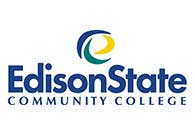|
|
 |
 |
Edison State receives
high marks for student success and satisfaction
Edison State Community College continues to build upon its history of
student success and commitment to continued improvement in student
satisfaction. The 2018 results of the National Community College
Benchmark Project (NCCBP) show Edison State performing in the top
25-percent in over 30 measures of student success and student
satisfaction.
Measured against 242 community colleges nationwide, student
satisfaction with Admissions and Financial Aid ranks Edison State in
the top 94th percentile. Overall student success for both full-time and
part-time students as measured by persistence from fall to fall and
successful student transfer and completion also rank Edison State in
the top 90th percentile.
The report notes that very few students withdraw from Edison State
courses. Dr. Larson notes that this is attributed to the dedication of
faculty to the success of every student in their courses.
“Our faculty will work with students, encourage students, and take all
the time needed for students to overcome barriers and succeed.”
Other areas of noted student satisfaction include the
student-centeredness of the college, campus safety and security,
service excellence, and concern for the individual. The college’s
strong financial position also ranks in the 90th percentile.
While receiving high marks in almost all areas, the college plans to
integrate any areas with opportunity for improvement into its continued
improvement strategy.
Dr. Larson stated that Edison State is one of the few community
colleges experiencing enrollment increases with fall 2018 enrollment up
by over 10%.
“It may be the affordability of Edison State that brings students here,
but it is the quality of service and strength of student support that
sustains our student enrollment, and it is the positive word of mouth
that serves as our most powerful marketing tool.”
The NCCBP is conducted annually by The National Higher Education
Benchmarking Institute. The full NCCBP report, available online,
contains more than 150 benchmarks on student demographics, measures of
student success, faculty and staff data, workforce and community
outreach, institutional characteristics and effectiveness metrics, and
financial and mobility measures.
|
|
|
|

